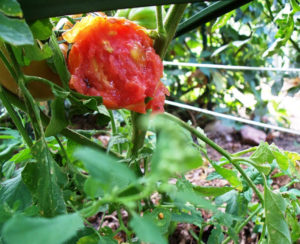 Gardeners start the season with such high hopes for growing bushels of beautiful tomatoes. Then August hits and we’re reminded that tomatoes can sometimes be challenging to grow.
Gardeners start the season with such high hopes for growing bushels of beautiful tomatoes. Then August hits and we’re reminded that tomatoes can sometimes be challenging to grow.
Often the problem is obvious, like when a hungry squirrel eats half a ripe tomato right off the vine. Other times, the problems come from plant diseases or insect pests.
Here are some common tomato problems for this time of year, and what to do about them:
Plants are wilting. Sometimes wilting is because plants need water and other times it’s because tomatoes are being overwatered. Before watering plants, be sure to check to make sure the first inch or two of soil is dry. If plants start to wilt in the middle of the day, even when the soil is moist, the problem may be a soil-borne fungal disease like verticillium wilt or fusarium wilt. Pull up plants that don’t recover and dispose of them in the trash.
Damage on tomatoes. When you see problems starting on the tomatoes, pick those fruits and toss them on the compost pile. There’s no reason to leave wormy fruit or tomatoes with blossom end rot on the plant because it takes energy away from forming other tomatoes.
Soil dries too quickly. Mulch around each plant (even in containers) with an organic mulch like thin layers of dry, untreated grass clippings, dried tree leaves, or straw. Water plants deeply, but infrequently.
Blossoms are dropping. When daytime temperatures heat up too quickly and nighttime temperatures remain high, tomato plants can drop their flowers. There’s not much you can do except to wait for cooler nighttime temperatures.
Spots on leaves. Spots could be caused by a fungus, most likely late blight at this point in the summer. Look for problem leaves growing on the upper part of plants that shrivel and die. In the future, space plants farther apart to help with air circulation and be sure to water at soil level to keep leaves dry.
Leaves disappear overnight. Look for tomato hornworms, those large green caterpillars that eat the leaves off plants. These insects are difficult to see because they’re the same color as the plants. Look closely, pick them off by hand and drop them into a paper bag or bucket of soapy water.
Leaves that yellow and curl. The problem could be psyllids, tiny insects that also feed on plants. Pick off the unhealthy leaves and throw them away, and then look on the undersides of healthy leaves. Hose off the insects with a blast of water early in the day so leaves have time to dry.
Tomatoes with cracks. Cracks that appear as circles at the stem end of the tomatoes or along the side are the result of rapid growth. This problem is usually caused by wet weather followed by dry weather. Use mulch and be sure to keep the soil deeply and evenly moist.
Leaves turn yellow and drop. Spider mites may be the culprit. Infestations of these pests show up as small specks on leaves. Look for these small red mites on the underside of leaves and hose them off with water. Keep checking to make sure they don’t return.
Tomatoes aren’t ripening. Root pruning may help speed up the ripening process. Remove any tomato blossoms that form in late August (they probably won’t have time to mature), stop fertilizing plants to slow growth, then use a shovel or hand trowel to cut through the roots around the plant, about 8 inches from the stem. Leave the soil in place. Pruning tells the plant to get busy ripening the fruit because the end of the season is near.


